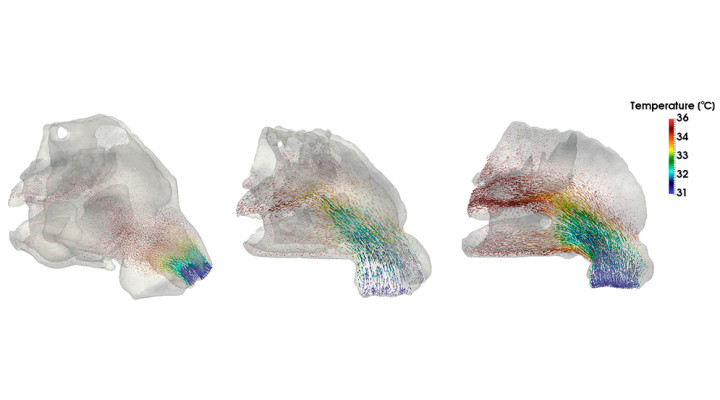The Neanderthals’ last breath
Argentine researchers managed to digitally reconstruct the nasal airflow in Neanderthals and simulate the respiratory cycle under different climatic scenarios.
Heavy frosts and severe climates are extreme conditions. How did humans manage to survive the last glaciation? Breathing is the answer. Although this seems to be obvious, a study published in PNAS (Proceedings of the National Academy of Sciences) claims that the internal nasal cavity of humans and Neanderthals –species that occupied extreme cold and dry landscapes– allowed them to warm and moisten the inhaled air. These results are vital to understand how our human lineage managed to resist severe climate conditions during their dispersion through Eurasia at the end of the Pleistocene epoch.
According to the study, this nasal acclimation ensured the proper functioning of the respiratory system and protected the body from infections.
“Understanding the adaptations that could have happened in the nasal morphology allows us to discover which evolutionary mechanisms occurred when our close cousins (Homo neanderthalensis) and some of the populations of our species (Homo sapiens) occupied the coldest climates of the Eurasian continent during the last glaciation”, Soledad de Azevedo, affirms. She is a CONICET’s assistant researcher who works at the Instituto Patagónico de Ciencias Sociales y Humanas (IPCSH CONICET-CENPAT).
Osvaldo Velán, specialist in diagnostic imaging at the Hospital Italiano in Buenos Aires, cooperated in the study. The research team gathered a collection of computed tomography images of current humans that included Chinese and Korean immigrants as well as Argentine people with ancestors who lived in the south of Europe.
The images allowed scientists to understand the shape variations of the nasal airflow and the bone structure that contains it according to the populations that evolved in cold climates (from northern Asia) or in temperate climates (from southern Europe). From that collection, the experts reconstructed how the nasal airflow of the Neanderthals would have been specifically in the remains from La Chapelle-aux-Saints (60 thousand years’ old) and from La Ferrassie (about 68 and 74 thousand years old). These fossils were found in France in 1908 and 1909 respectively.
“Our aim was to compare how the southern European, the northern Asian and the Neanderthal nose models worked by using Computational Fluid Dynamics’ techniques, a kind of computerized wind tunnel which simulates the breath of those three virtual noses in different climate conditions”, Azevedo explains.
The results indicated that the human model of northern Asia performed best under low temperatures because it warms quickly the air in the front part when it inhales. Despite the great bone differences, the Neanderthal nose also worked efficiently in cold climates.
“From the evolutionary point of view, the study suggests that Neanderthals and humans “solved” in an adaptive way the problem of the cold and dry air with convergent changes in the nasal airflow: even though both species had different “bone structures”, what allowed them to perform well at breathing was their internal anatomy. Each species developed their own optimal “heater” independently, but both with thermodynamic efficiency”, the scientist concludes.
This interdisciplinary work conducted by researchers, engineers, anthropologists, paleontologists, biologists and physicians not only contributed to the reconstruction and understanding of the functioning of the nasal mucosa of the Neanderthals but also opens the way to have a line of possible applications in heath.
“The respiratory simulation developed by the research team is going to be adapted to be used in clinical practice to study with non-invasive methods the impact of drugs or surgeries aimed at improving breathing (and therefore the quality of life) in patients with pathologies linked to the nasal mucosa (apnea, snoring, swellings, traumas, etc.)”, Rolando González-José, principal researcher and director at the Instituto Patagónico de Ciencias Sociales y Humanas (IPCSH CONICET-CENPAT), affirms.
By Alejandro Cannizzaro
About the study:
Title: Nasal airflow simulations suggest convergent adaptation in Neanderthals and modern Humans. Proceedings of the National Academy of Sciences.
Authors and affiliations
Soledad de Azevedo 1
Marina González 1
Celia Cintas 1
Virginia Ramallo 1
Mirsha Quinto-Sánchez 2
Federico Márquez 3
Tábita Hünemeier 4
Carolina Paschetta 1
Anahi Ruderman 1
Pablo Navarro 1
Bruno Pazos 1
Caio Silva de Cerqueira 5
Osvaldo Velán 6
Fernando Ramírez-Rozzi 7
Nestor Calvo 8
Guillermo Castro 9
Rodrigo Paz 10
Rolando González-José 1
1 Instituto Patagónico de Ciencias Sociales y Humanas- Centro Nacional Patagónico-CONICET
2 Licenciatura en Ciencia forense, Facultad de Medicina, Universidad Nacional Autónoma de México, México.
3 Instituto de Biología de Organismos Marinos, Centro Nacional Patagónico – CONICET
4 Departamento de Genética e Biologia Evolutiva (IB), University of São Paulo, São Paulo, Brasil
5 Superintendência da Polícia Técnico-Científica do Estado de São Paulo
6 Departamento Académico de Ciencias Morfológicas. Hospital Italiano
7 Unité Propre de Recherche 2147, Centre National de la Recherche Scientifique, Paris, France
8 Universidad Nacional del Litoral
9 Universidad Nacional del Nordeste (UNNE)
10 UTN-FRRe, 10Livermore Software Technology Corporation (LSTC) – CONICET
